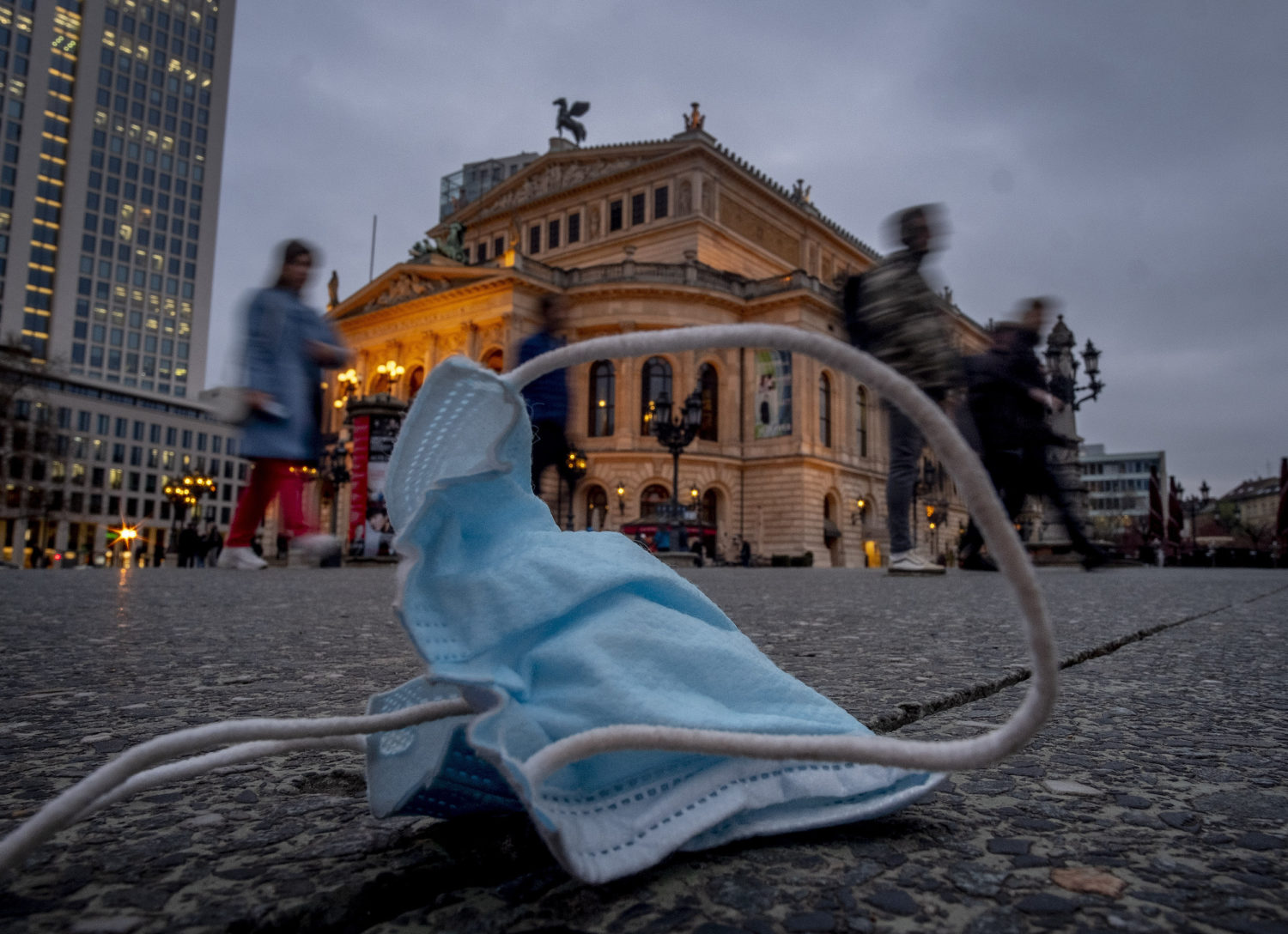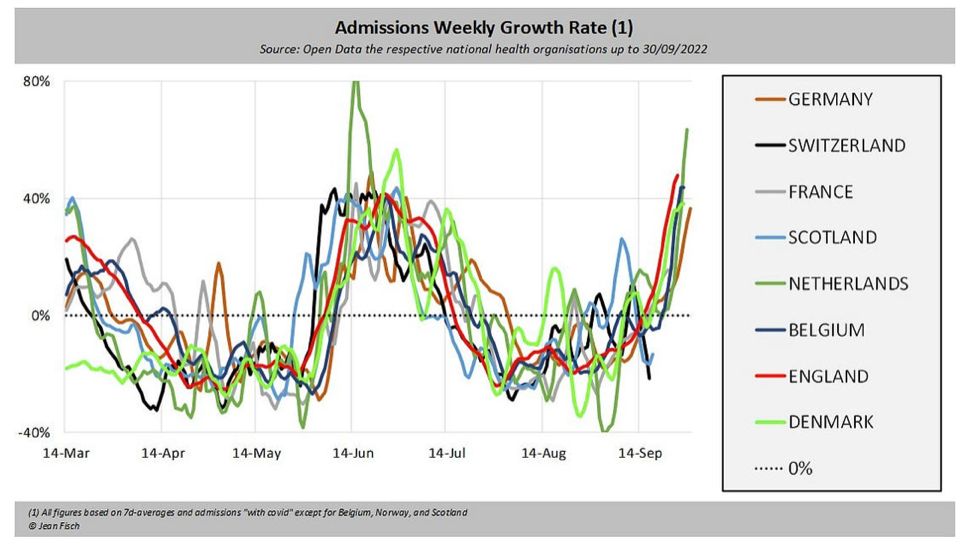 Covering COVID-19 is a daily Poynter briefing of story ideas about the coronavirus and other timely topics for journalists, written by senior faculty Al Tompkins. Sign up here to have it delivered to your inbox every weekday morning.
Covering COVID-19 is a daily Poynter briefing of story ideas about the coronavirus and other timely topics for journalists, written by senior faculty Al Tompkins. Sign up here to have it delivered to your inbox every weekday morning.
By now, we have come to understand how COVID-19 moves around the globe. If past predicts future, an autumn wave is building. As you will see in this update, researchers say a fall/winter COVID-19 wave is not inevitable, but it is becoming more likely. How big and how bad depends on several factors.
This data is through the end of September across Western Europe:
Keep in mind that some of the countries report patients “with COVID-19” who might also have other conditions that require hospitalization. As epidemiologist Katelyn Jetelina points out, Germany’s data accounts purely for COVID-19 cases, so pay special attention to that red line. One clue about why Germany’s figures rose so sharply could be this:
Nature.com reported this week:
Evidence is building that the northern hemisphere is on course for a surge of COVID-19 cases this autumn and winter. New immune-evading strains of the SARS-CoV-2 Omicron variant, behaviour changes, and waning immunity mean that many countries could soon see large numbers of COVID infections — and potentially hospitalizations — say scientists.
This summer, a group called the COVID-19 Scenario Modelling Hub projected that the U.S. might not suffer a fall and winter wave if people take advantage of the newest vaccine boosters and if there is no new highly infectious variant. But, as I reported earlier this week, a large portion of Americans don’t know about or don’t care about the new booster doses. And as Nature.com points out:
In the backdrop, a slew of immunity-dodging variants are emerging globally, and researchers think these variants will fuel an autumn–winter wave.
Probably not yet, says Tom Wenseleers, an evolutionary biologist at the Catholic University of Leuven in Belgium. The current rise in SARS-CoV-2 infections is probably largely because of people’s waning immunity — which offers short-lived protection from infection — as well as increased mixing between people. In many countries including the United Kingdom, social dynamics are nearly back to pre-pandemic levels, say health officials. Factors that cause other respiratory viruses to thrive in cooler months — including extra time spent indoors — could also be at play.
Dr. Jetelina says:
Interestingly, no new subvariant is driving this wave, as the majority of cases are still the “old” BA.5 subvariant. This means changing weather, waning immunity, and/or changing behaviors are the culprit. This theory is only solidified when we see patterns are not changing in neighboring country Israel, for example, whose weather hasn’t started changing yet.
The website Pandem-ic includes a graphic that shows how COVID-19 waves in Europe and the U.S. have synchronized over the last couple of years. Look at the graphic as a mirror image and see how European and U.S. cases grow in unison.
The Biden admin’s college loan debt forgiveness signup could begin this week
Soon, perhaps right away, applications are expected to open for millions of people to apply for President Joe Biden’s student loan forgiveness plan. Democrats would love to get the application process running before the midterm elections.
The plan, which is facing a bevy of legal threats, is aimed at individuals who earned less than $125,000 in either 2020 or 2021 and married couples or heads of households who made less than $250,000 annually in those years. The people and households that qualify will see up to $10,000 of their federal student loan debt forgiven.
You may have heard that about 700,000 people who might have thought they were eligible under Biden’s original proposal in August are not eligible now. The administration, faced with lawsuits, scaled back eligibility for the program to exclude borrowers whose federal student loans are guaranteed by the government but held by private lenders.
Six state attorneys general (Arkansas, Iowa, Kansas, Missouri, Nebraska, and South Carolina) joined a lawsuit saying the president’s plan puts the costs on the backs of people who struggle to pay their bills and that the president does not have the legal authority to grant such forgiveness.
Here is what studentaid.gov says people can do right now to be ready to apply when the government website opens:
- Log in to your account on StudentAid.gov and make sure your contact info is up to date. We’ll send you updates by both email and text message, so make sure to sign up to receive text alerts. If it’s been a while since you’ve logged in, or you can’t remember if you have an account username and password (FSA ID), we offer tips to help you access your account.
- If you don’t have a StudentAid.gov account (FSA ID), you should create an account to help you manage your loans.
- Make sure your loan servicer has your most current contact information so they can reach you. If you don’t know who your servicer is, you can log in and see your servicer(s) in your account dashboard.
- To be notified when the process has officially opened, sign up at the Department of Education subscription page.
The federal government is promising that the application process will be easy. CNN says:
The online application will be short, according to the Department of Education. Borrowers won’t need to upload any supporting documents or use their Federal Student Aid ID to submit the application.
“Once you submit your application, we’ll review it, determine your eligibility for debt relief and work with your loan servicer(s) to process your relief. We’ll contact you if we need any additional information from you,” the department said an email to borrowers last week.
Borrowers will have more than a year to apply. The deadline will be December 2023.
OPEC cuts production. Oil and gasoline prices will rise.

People and media gather at the entrance of the building of the Organization Of The Petroleum Exporting Countries, OPEC, in Vienna, Austria, Wednesday, Oct. 5, 2022. (AP Photo/Philipp-Moritz Jenne)
Some of the world’s biggest oil producers all but guaranteed that you would be paying higher energy prices for the foreseeable future. The Organization of the Petroleum Exporting Countries and its non-OPEC allies, a group often referred to as OPEC+, announced they will reduce production by 2 million barrels per day starting in November. Global oil prices immediately rose 1% on the news. The move worries everyone who hoped lower oil prices this winter might keep winter heating bills from spiraling.
After a summer of steadily falling gasoline prices, this could have significant political repercussions. Politico notes:
Average gasoline prices sat at $3.83 per gallon on Wednesday, nearly seven cents higher than a week ago, but well below the record high $5.01 per gallon average national price reached in June. The White House has touted its tapping of the nation’s Strategic Petroleum Reserve as driving that drop, crediting the release of more than 171 million barrels so far this year for cooling off the market. Those supplies will continue to flow out federal storage facilities through November, but they will pale with the potential drop in OPEC supplies.
If prices rise now, it will cost the federal government more money to buy the oil it will need to replenish the oil reserve.
Why journalists should not trust the newest FBI crime figures
Right about this time every year, journalists dutifully report the newest federal crime data based on a system we all came to know as the Uniform Crime Report, which has been produced annually for close to a century. But that system had big problems, not the least of which was if a criminal committed, say, four crimes all in one incident, it might be logged as just one of those crimes.
As my colleague Kelly McBride explains in a Poynter report, the new system, called the National Incident-Based Reporting System, has at least five big problems as well.
All of this may sound vaguely familiar to you. In July, I flagged this new system that was shaping up to be incomplete because so many states had not submitted all of their data to the federal agency.
By the way, keep an eye out for future seminars and workshops from Kelly, who, these days, is spending a lot of time helping newsrooms rethink their crime coverage. She has already worked with more than 50 TV, newspaper, radio and online newsrooms reforming crime coverage. Kelly came up in the business as a police reporter, so she has a real passion for this topic. (I think this is where I should also point out that she is my boss.)
The battle over braces

A scanned image of a patient’s teeth is shown on a display of a 3-D scanner in SmileDirectClub’s SmileShop located inside a CVS store Wednesday, April 24, 2019, in Downey, Calif. (AP Photo/Jae C. Hong)
Axios found an interesting story in the business of Americans who are willing to pay to straighten their teeth.
The pandemic triggered a boom in sales of teeth aligners. Invisalign and SmileDirectClub’s sales soared as customers figured it was a good time to fix their crooked teeth, a medical condition known as malocclusion.
“You’re sitting at home, you’re on Zoom all day, you have some extra coin in your pocket and a lot of people decided to do that,” Jefferies analyst Brandon Couillard, who tracks the teeth alignment industry, tells Axios.
SmileDirectClub has attacked state dental boards that it views as protecting the orthodontics industry. The company in March won a ruling from the 9th Circuit Court of Appeals allowing it to sue the members of California’s state dental board, alleging that they violated antitrust law in a conspiracy to block SmileDirectClub’s services.
The American Association of Orthodontists “has filed complaints with more than 35 state dental boards and authorities against SmileDirectClub (SDC), alleging specific regulatory and statutory violations.” The doctor’s group says, “The AAO has long held the position that it is in the best interest of the public to have orthodontic treatment conducted under the direct, ongoing supervision of a licensed orthodontist. Orthodontic treatment is a professional service and a complex medical process, not a product or device.”
October is Dental Hygiene Month and Orthodontic Health Month, but it is also the month for Halloween. They sort of offset each other, don’t they?
We’ll be back tomorrow with a new edition of Covering COVID-19. Are you subscribed? Sign up here to get it delivered right to your inbox.










